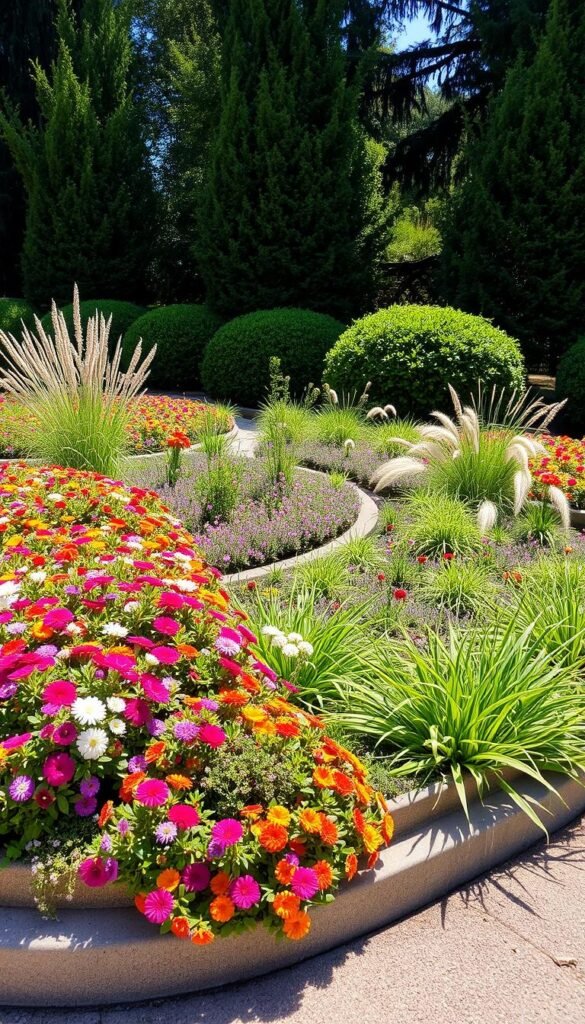Ever wonder how to give your yard that magazine-ready appearance? The secret lies in creating sharp, well-maintained lines between your planting areas and pathways. Properly executed boundary definition does more than beautify – it keeps grass from invading your blooms and adds structure to your overall layout.
Whether you’re working with recycled materials or investing in long-lasting solutions, there’s an approach for every budget. You’ll find methods ranging from simple weekend projects to more involved installations that stand the test of time. The right choice depends on your preferred aesthetic, whether that’s cozy cottage vibes or sleek contemporary lines.
Maintaining those crisp lines becomes easier when you use the proper tools. Many enthusiasts find success with basic equipment like a garden hose for layout planning and hand shears for precision trimming. For curved designs, specialized tools like the Black & Decker Edge Hog make shaping effortless. Discover professional tips for achieving perfect edges for your beds that stay neat all season.
This guide walks through creative upcycling options that save money while reducing waste. You’ll learn maintenance secrets like optimal mulching depth and seasonal care routines. By the end, you’ll have all the knowledge needed to create eye-catching boundaries that elevate your entire property’s appearance.
Understanding the Benefits of Garden Edging
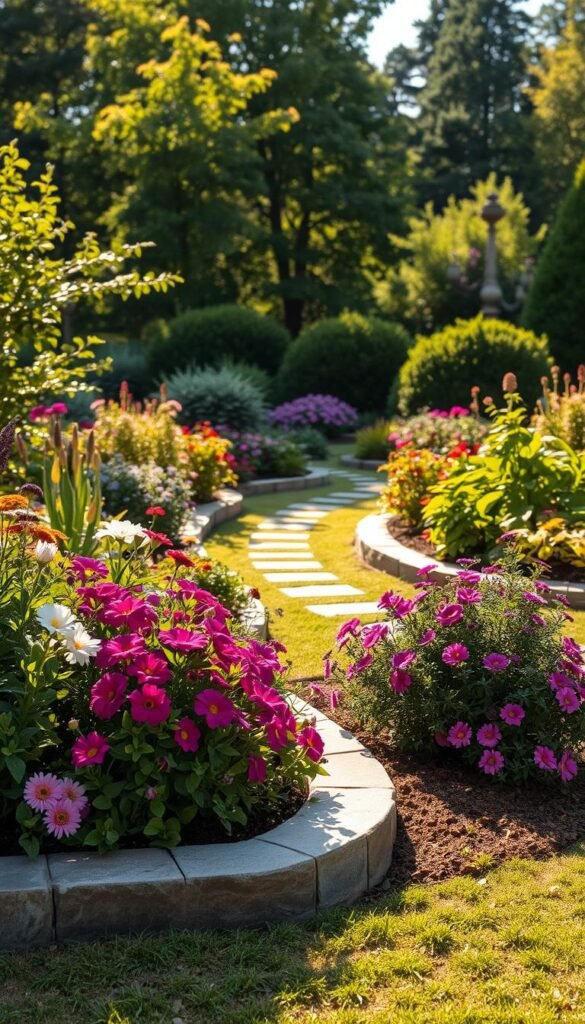
Sharp boundaries transform chaotic green spaces into intentional landscapes. Thoughtful border solutions do more than prettify your yard – they create order where nature prefers randomness.
Where Beauty Meets Purpose
Clean edges act like picture frames for your favorite plants. They make Rudbeckia blooms pop against emerald grass and give rose bushes their own spotlight. This visual hierarchy guides attention to your hardiest perennials or newest building raised beds projects.
Well-defined beds simplify care routines. You’ll spend less time rescuing tulips from crabgrass and more enjoying your morning coffee among the blossoms. Proper borders also:
- Keep mulch where it belongs
- Direct rainwater to root zones
- Create mowing paths that protect delicate stems
Smart Solutions Grow Here
Your space becomes more functional with intentional design. Curved metal strips prevent soil erosion on slopes, while brick borders double as casual seating. One gardener shared:
“Since adding stone edging, I’ve cut my weeding time in half – the clarity helps me spot invaders early.”
Seasoned landscapers recommend matching border heights to your plants’ growth patterns. Low-profile edges work for ground covers, while taller barriers contain spreading grasses. This strategic approach ensures your garden stays photo-ready with minimal effort.
Exploring Budget-Friendly Edging Options
Smart landscape design starts with practical solutions that don’t drain your wallet. You’ll find plenty of durable materials and clever ideas to shape your outdoor spaces effectively.
Inexpensive Materials and Techniques
Plastic edging offers unbeatable value for money. While it might not win design awards, this option lasts over a decade with proper care. Pound-in versions let you handle installation solo – just tap stakes into the ground every few feet.
| Type | Cost | Lifespan | Best For |
|---|---|---|---|
| Roll Plastic | $0.50/ft | 8-10 years | Straight lines |
| Pound-In | $0.75/ft | 12+ years | Curved designs |
| Recycled Timber | Free-$1/ft | 5-7 years | Rustic looks |
In colder zones, frost heave might lift sections slightly. A springtime walk with a rubber mallet easily fixes this. Pair with season extension methods to protect nearby plants during temperature swings.
Creative Upcycling Ideas
Turn discarded items into charming borders. Old bicycle rims create whimsical circles around trees. Salvaged roof tiles make zig-zag patterns that channel Mediterranean vibes. One homeowner shared:
“My wine bottle border cost nothing but time – neighbors saved bottles all winter!”
Landscape timbers offer another thrifty solution. Seal them with eco-friendly stain for extra years of service. These approaches prove you can craft eye-catching edges while keeping cash in your pocket.
Unique DIY Garden Border Ideas for Cottage Gardens
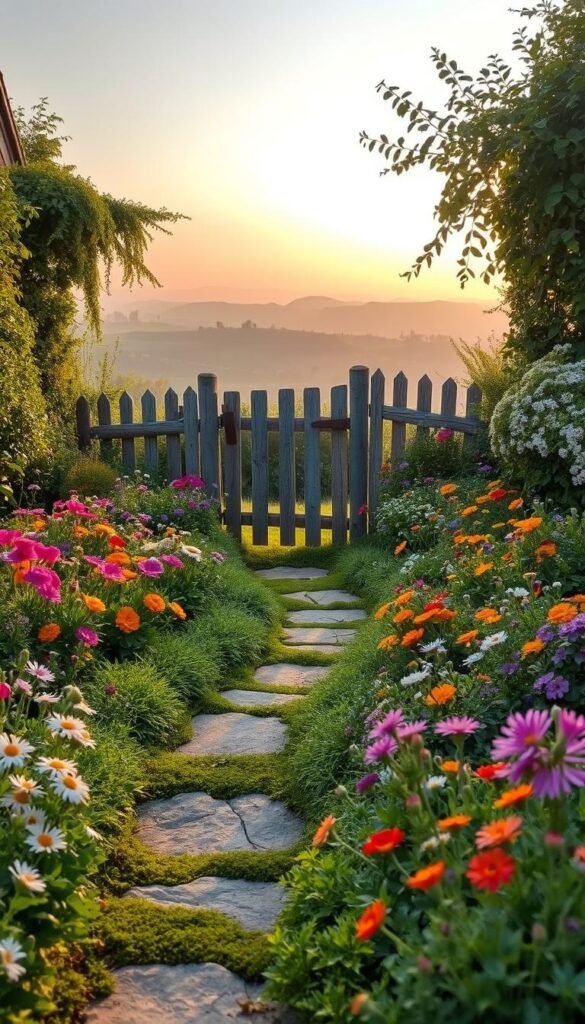
Quaint landscapes deserve boundaries that match their whimsical spirit. Cottage-style plantings thrive with edges that feel discovered rather than designed, blending functionality with nostalgic appeal.
Timeless Wood Accents
Fallen branches become natural borders when arranged along planting areas. Half-buried logs create instant definition, while sliced tree rounds make charming stepping stones. These wood elements develop a silvery patina over time, harmonizing with climbing roses and lavender.
Glass Revival Projects
Turn discarded bottles into sparkling garden art. Bury them neck-down in staggered rows, creating colorful light patterns at sunrise. Green glass mimics dewdrops on foliage, while blue varieties echo hydrangea blooms. A local gardener notes:
“My cola bottle border stopped neighborhood foot traffic through my flowerbed – and cost zero dollars!”
| Material | Cost | Installation | Lifespan |
|---|---|---|---|
| Log Sections | Free-$2/ft | 30 minutes | 3-5 years |
| Wine Bottles | Free-$0.50/unit | 2 hours | Indefinite |
| Willow Wattle | $1-$3/ft | 4 hours | 7-10 years |
Woven willow branches offer another natural look that supports climbing plants. These living fences soften hard lines while providing habitat for beneficial insects. Combine different heights for layered visual interest that complements your cottage’s architecture.
Traditional and Modern Edging Techniques for a Clean Look
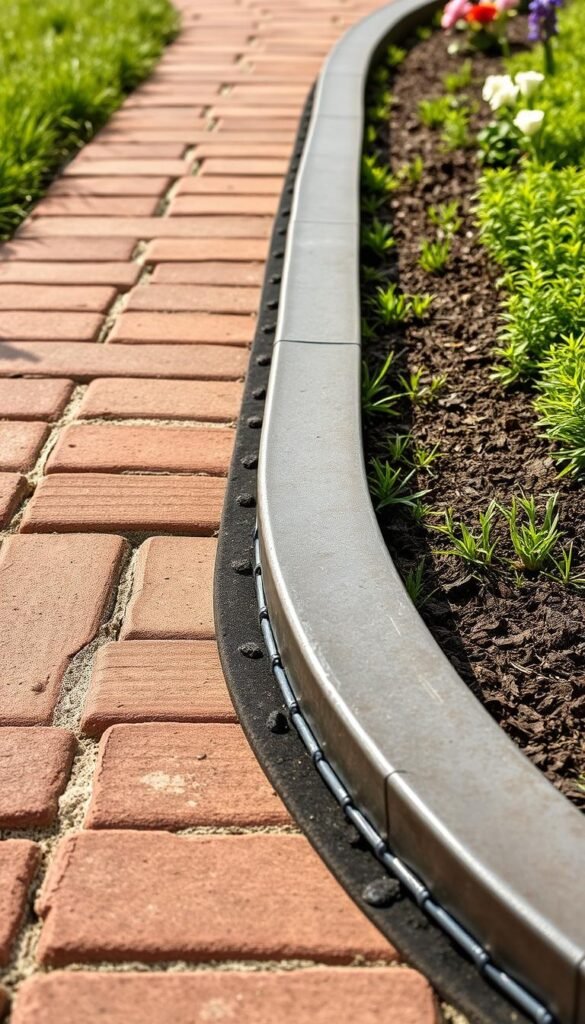
Blending classic craftsmanship with contemporary flair gives your outdoor spaces character that evolves with time. These approaches balance practicality with design-forward thinking, offering solutions for every taste.
Brick and Stone Combinations
Brick edging brings old-world charm to modern landscapes. Stacked walls create vertical interest while keeping aggressive roots in check. For lasting results, consider hiring a mason – their expertise ensures proper alignment and drainage behind the structure.
Mix brick colors and laying patterns to mirror your home’s exterior. Pair red clay varieties with stones for textural contrast. One landscaper notes:
“Clients love how sandstone caps soften brick’s rigid lines – it’s like framing nature’s artwork.”
Metal and Glass Accents
Sleek metal edging defines spaces without competing with your plants. Corten steel develops a rust-toned finish that complements autumn foliage. Its weighty presence stops groundcovers from creeping onto walkways.
Recycled glass chunks add sparkle between pavers or as standalone borders. Tempered panels create reflective surfaces that make small areas feel expansive. These materials work particularly well in urban settings where clean lines matter.
| Material | Installation | Key Benefit |
|---|---|---|
| Brick Wall | Professional | Height control |
| Corten Steel | Moderate skill | Weather resistance |
| Glass Panels | DIY-friendly | Light reflection |
DIY Flower Garden Borders: Edging Techniques for a Clean, Defined Look
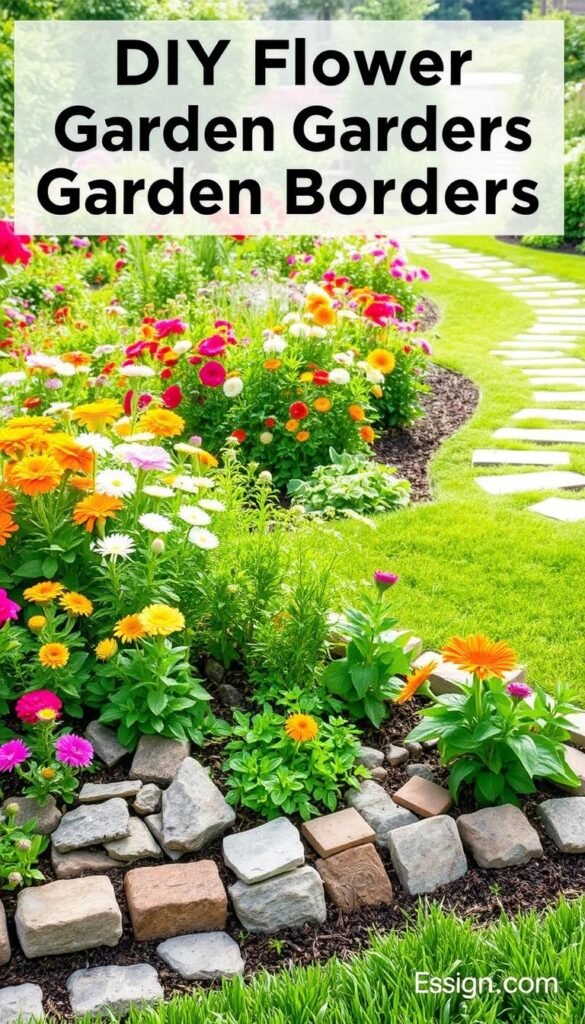
Creating crisp borders starts with understanding your landscape’s unique needs. Check your soil type by squeezing a handful – sandy earth crumbles quickly, while clay holds its shape. This simple test determines whether you’ll need extra drainage solutions or soil amendments before installing your chosen edging materials.
Proper preparation prevents shifting borders over time. Mark your desired lines with flour or spray chalk, then dig a 4-inch trench along the path. Remove rocks and roots to create a smooth base. For sloped areas, angle the trench downward to prevent water pooling behind the border.
Choose installation methods that match your skill level:
- Hand-cut edges work for small beds – use a half-moon edger for clean curves
- Prefabricated strips simplify large projects – snap together sections with hidden connectors
- Mortared stone requires more effort but lasts decades
Maintain consistent height by setting a string guide between stakes. One landscaper notes:
“A laser level transformed my curved edges from wobbly to workshop-precise.”
Refresh trenches annually with fresh mulch to combat soil erosion, keeping yourperfect edgeslooking sharp through seasons.
Step-by-Step Guide to Creating a Crisp English Edge
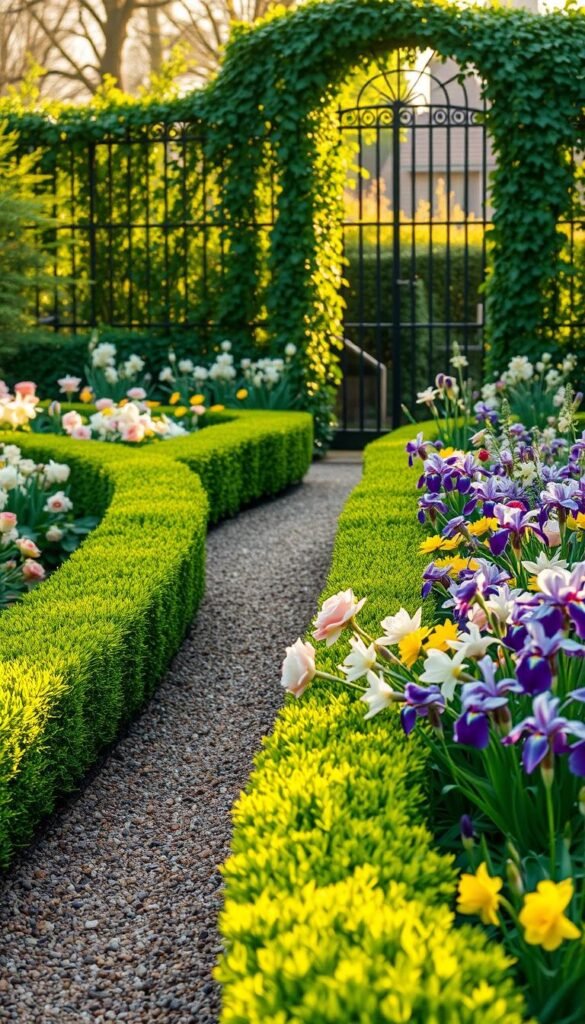
Achieving that timeless English charm in your landscape begins with precise lines and simple tools. This method focuses on natural shapes that highlight your plantings while keeping maintenance manageable. Let’s break down the process into two essential phases.
Mastering the Cut
Start by marking your desired boundary with twine or spray paint. A half-moon edger slices through turf effortlessly – push it straight down 6 inches, then rock it slightly to form a V-shaped trench. This angled groove prevents grass roots from crossing into your planting area.
| Tool | Depth | Best For |
|---|---|---|
| Half-Moon Edger | 6″ | Curves & Corners |
| Spade | 4-5″ | Straight Lines |
| Trenching Shovel | 8″ | Sloped Areas |
One landscaper shares their secret:
“Wetting the soil first makes cutting cleaner – dry earth crumbles too easily.”
Remove loose dirt from the trench to maintain sharp lines.
Mulch Magic
Fill the V-shaped channel with shredded bark or cocoa hulls, mounding it slightly toward your garden. This creates a natural barrier that:
- Blocks sunlight from weed seeds
- Retains moisture for plant roots
- Prevents soil erosion during rains
Refresh the mulch every spring and fall. Over time, organic materials break down, enriching the soil while keeping your edges looking freshly defined. This system works year after year without plastic or metal inserts.
Upcycling for Eco-Friendly Edging Projects
Transform everyday items into striking landscape features that protect the planet. Upcycled materials breathe new life into discarded objects while adding personality to your outdoor space. Let’s explore inventive ways to turn trash into treasure along your planting beds.
Using Recycled Materials in Your Garden
Glass bottles create shimmering borders when planted neck-down in staggered rows. Clear varieties catch sunlight like dew, while green and blue types complement foliage. A Midwest gardener reports:
“My soda bottle edge survived three winters – neighbors still ask where I bought the ‘glass tiles’!”
Recycled rubber strips offer another planet-friendly option. Made from old tires, this flexible edging withstands lawnmower blades and extreme weather. Installation takes minutes:
- Unroll strips along marked lines
- Secure with included stakes
- Backfill with soil or mulch
| Material | Cost | Installation | Lifespan |
|---|---|---|---|
| Glass Bottles | Free-$0.50/unit | 2 hours | Indefinite |
| Rubber Strips | $1.25/ft | 30 minutes | 15+ years |
| Pallet Wood | Free-$0.75/ft | 1 hour | 5-7 years |
Concrete chunks from demolition sites make rugged borders when stacked creatively. Paint them with outdoor-safe colors to match your garden theme. These projects reduce landfill waste while giving your yard one-of-a-kind character.
Enhancing Garden Design with Mixed Material Borders
Your outdoor space becomes a canvas when you mix materials creatively. Blending textures adds depth to your landscape while solving practical needs. This approach lets you highlight favorite plants and direct foot traffic naturally.
Combining Stone, Wood, and Metal
Stone elements anchor your design with timeless appeal. Pair flat flagstones with vertical wooden stakes for contrast. Metal strips between materials create clean divisions that stop spreading roots. One landscaper suggests:
“Lay gravel behind stone borders – it improves drainage while making weed removal easier.”
Creative Layout Ideas for Unique Borders
Alternate materials in geometric patterns for modern style. Try stone squares flanked by wood planks, with metal edging defining the outer edge. Curved metal bands work well between garden zones, guiding visitors without obvious barriers.
For cottage charm, nestle rounded river stones against weathered wood. Add copper accents that develop a patina over time. These combinations create borders that feel intentional yet organic, enhancing your overall design.

